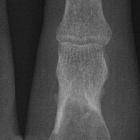Türflügelzeichen

Juvenile
Knochenzyste Humerus mit pathologischer Fraktur und so genanntem "fallen fragment sign" oder "Türflügelzeichen"


Unicameral
bone cyst • Unicameral bone cyst - Ganzer Fall bei Radiopaedia

Unicameral
bone cyst • Unicameral bone cyst with fracture - humerus - Ganzer Fall bei Radiopaedia
The fallen fragment sign refers to the presence of a bone fracture fragment resting dependently in a cystic bone lesion. This finding is said to be pathognomonic for a simple (unicameral) bone cyst following a pathological fracture. Although it has occasionally been reported with other cystic lesions, e.g. eosinophilic granuloma .
The finding exists because a simple bone cyst is fluid filled, and therefore a bony fragment may descend through the fluid uninhibited. In contrast, the common differential lesions for a pathologic fracture through a lucent bone lesion (such as a lytic tumor, fibrous dysplasia, aneurysmal bone cyst or enchondroma) have a solid interior matrix and therefore would not permit such downward fragment migration.
Siehe auch:
und weiter:

 Assoziationen und Differentialdiagnosen zu Türflügelzeichen:
Assoziationen und Differentialdiagnosen zu Türflügelzeichen:


